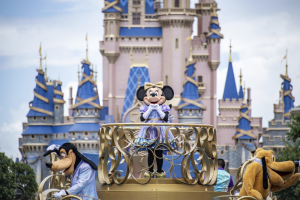Flagship streaming service added 12.1 million new members, more than analysts expected, while parks division sets a new record

Disney’s theme parks division has raised prices but also introduced new technology to reduce crowd sizes and coax guests to return.
Walt Disney Co. reported weaker-than-expected fourth-quarter earnings Tuesday as losses continued to widen in the streaming business, offsetting the strong performance of the company’s theme parks.
In the three months ended Oct. 1, the company’s flagship streaming service Disney+ added 12.1 million net new accounts, bringing its global total to 164.2 million subscribers. Analysts were expecting 8.86 million additions, according to FactSet.
Disney Chief Executive Bob Chapek has indicated that Disney+ is entering a new phase that gives priority to income over rapid growth, but so far the company has struggled to translate subscriber additions into profits.
Disney’s streaming segment lost $1.47 billion in the fourth quarter, a loss of more than twice that of the year-earlier period and 38% wider than what analysts polled by FactSet had predicted. Since Disney+ launched three years ago, Disney’s streaming segment has lost more than $8 billion.
Mr. Chapek on Tuesday hinted at cost cuts in the near future and said his outlook for the streaming service remains rosy. He said that “realigning our costs”—as well as price increases for some Disney+ packages and a new ad-supported subscription tier that will both take effect Dec. 8—will allow the service to achieve its goal of profitability by September 2024.
“The rapid growth of Disney+ in just three years since launch is a direct result of our strategic decision to invest heavily in creating incredible content and rolling out the service internationally,” and the company expects to pare losses in the division going forward, Mr. Chapek said. “Disney+ will still achieve profitability in fiscal 2024, assuming we do not see a meaningful shift in the economic climate.”
For the quarter ended Oct. 1, Disney reported earnings of $162 million, or 9 cents a share, slightly above the year-ago earnings of $159 million, or 9 cents a share. Excluding certain items, the company had earnings of 30 cents a share, down from 37 cents per share in the year-earlier quarter. Analysts, on average, were expecting earnings of 56 cents a share, excluding items, according to FactSet.
Revenue rose 9% from a year ago to $20.2 billion. Analysts were expecting revenue of $21.27 billion, FactSet said.
Disney’s income from operations for the quarter totaled $1.6 billion, down 55% from the previous quarter and on par with the year-ago quarter.
The company’s theme parks division set a new record for revenue with $7.42 billion for the quarter, up 36% from a year earlier. Disney said the full-year results from the theme parks division set all-time records for the company in both revenue and operating income.
Shares of Disney fell more than 6% in after-hours trading. Before the results were released, the stock closed Tuesday at $99.90, down 35.5% in 2022.
As the streaming industry matures, most companies are raising prices, including Disney. The ad-supported tier of Disney+ will compete with a similar product launched by rival Netflix Inc. this month.
“Streaming is a critical mass business. Scale is really, really important in order to be able to thrive,” Mr. Chapek said last month at The Wall Street Journal Tech Live conference in Laguna Beach, Calif. In the future, consolidation will lead to fewer streaming services and force companies like Disney to offer more services through their streaming platforms, he added.
This month, Disney launched a test program that placed links inside the Disney+ app allowing users to buy exclusive merchandise related to Star Wars, Marvel Studios and other popular franchises the company owns.
Some Disney watchers say the company faces a difficult balancing act between spending enough money on popular shows and movies to attract new subscribers, finding the right pricing point for dozens of different markets and reining in costs so streaming can break even.
Since the spring, shares of media companies that rely on streaming have tumbled across the board, as investors have grown more pessimistic about the prospects of near-term profitability for streaming.
“The halcyon days of total growth and number of subscribers, those days are over,” said Chris Legg, senior managing director at investment bank Progress Partners, which advises companies in the media and advertising technology space.
“Disney is still in the mind-set of go-and-grab more subscribers, whether it’s locally or internationally. They probably have a few quarters to keep playing that game, but Wall Street is definitely getting less patient with this spend-for-subs model,” Mr. Legg. said.
Published via: The Wall Street Journal


